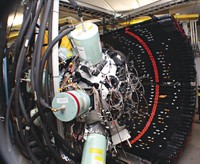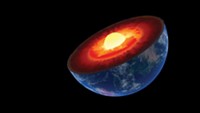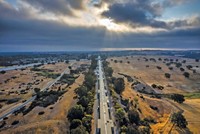Advertisement
Grab your lab coat. Let's get started
Welcome!
Welcome!
Create an account below to get 6 C&EN articles per month, receive newsletters and more - all free.
It seems this is your first time logging in online. Please enter the following information to continue.
As an ACS member you automatically get access to this site. All we need is few more details to create your reading experience.
Not you? Sign in with a different account.
Not you? Sign in with a different account.
ERROR 1
ERROR 1
ERROR 2
ERROR 2
ERROR 2
ERROR 2
ERROR 2
Password and Confirm password must match.
If you have an ACS member number, please enter it here so we can link this account to your membership. (optional)
ERROR 2
ACS values your privacy. By submitting your information, you are gaining access to C&EN and subscribing to our weekly newsletter. We use the information you provide to make your reading experience better, and we will never sell your data to third party members.
Physical Chemistry
192 Lasers Converge
Livermore Lab's National Ignition Facility is gearing up to focus on the inner workings of planets and stars, fusion energy research
by Jyllian Kemsley
March 30, 2009
| A version of this story appeared in
Volume 87, Issue 13

START WITH a small, low-energy laser pulse. Split that into 48 beams and amplify them to about 5 J apiece. Then, split the 48 into 192 beams, each about 40 cm2, and amplify again until they reach about 20 kJ each.






Run the beams to a spherical chamber—half to circle the top hemisphere, half to circle the bottom. Angle them into the chamber, convert them from infrared to ultraviolet light, and converge them on a target to deliver 1.8 MJ of energy to a sample a mere 2 mm in diameter. And do it all so that the beams hit the target, about one millisecond after the initial pulse, within 10 picoseconds of each other.
That's what's done at NIF, the National Ignition Facility located at Lawrence Livermore National Laboratory (LLNL). The goal of NIF is high-energy-density research, including experiments to understand both the workings of massive planets and the stars. Experiments at NIF will also help advance the use of fusion for energy and the stewardship of nuclear weapons stockpiles.
NIF was slated to be complete by March 31, but construction was finished in January, and the facility is now being commissioned with low-energy laser beams. LLNL scientists and technicians will slowly ramp up the power over the upcoming months, and they expect to fire the first "shot" of all 192 beams together at full strength this summer.
To see NIF in person is to be overwhelmed. Much of it is enormous: the two cavernous laser bays, each with 96 40- by 40-cm tubes; the massive target chamber, which is 10 meters in diameter and made of 10-cm-thick aluminum; the giant, 350-kg crystals that get sliced up into lenses; the 7,500 large optics, 26,000 small optics, and 60,000 computer control points; the 1,900 L of liquid argon that the facility uses each day to keep the laser tubes free of air; and the $3.5 billion price tag.
In contrast, there's the target. "We built this football-stadium-sized facility in order to have these gargantuan lasers, and they're all focused down" on a minuscule pellet of material, says Jeff Atherton, a chemical engineer and deputy principal associate director for NIF science and technology.
To get NIF started, LLNL provided seed grants to several groups to design targets and experiments for the facility. Raymond Jeanloz, a professor of earth and planetary science at the University of California, Berkeley, leads one of those groups. Jeanloz' research is focused on understanding so-called giant planets, such as Jupiter and Saturn, or even larger supergiant planets, in which temperatures are thousands to tens of thousands of degrees Celsius and pressures are millions or even billions of atmospheres.
THOSE CONDITIONS mean that matter in supergiant planets can be 100-fold more dense than on Earth. "The consequence, especially for heavier elements, is that the chemical bond now engages the core electron orbitals," Jeanloz says. "We're really entering a regime of chemistry that's never been explored before." Even theoreticians haven't probed the area very much, he says, because there was no way to determine whether their predictions are correct. Now, that experimental capability will be available at NIF. "It's motivating theoreticians to calculate and make predictions of what kinds of crystal structures would be stable, what kinds of liquids might be stable, what the physical and chemical properties of materials are, and what kinds of compounds can be formed," Jeanloz says.
Jeanloz is looking at three types of experiments in particular. One is to explore the nature and strength of solid materials at extremely high densities. Another is to determine what crystal and liquid structures of iron are stable at hundreds of millions of atmospheres.
The third is to look more specifically at the conditions of giant and supergiant planets, which typically are composed of hydrogen and helium with smaller quantities of other elements. "There are very interesting issues having to do with the interiors of Jupiter, Saturn, and the like," Jeanloz says. Going toward the planets' centers, "partway down hydrogen is a metallic fluid, but helium is nonmetallic. What is expected is that they're chemically immiscible and separate out like oil and water. But at yet higher pressure, helium becomes metallic and then alloys with hydrogen."
The way Jeanloz' experiments will work is that when the lasers hit the outside of a sample, say of iron or hydrogen and helium, the outer surface quickly becomes very hot. A plume of vapor blows back to the laser, which in return drives a shock wave into the sample, compressing the material to give the temperatures and pressures akin to planetary interiors. The total length of time is at most 20 nanoseconds.
For experimental data, Jeanloz and colleagues may use a pulse of X-rays skimmed off the laser beams to get X-ray diffraction patterns; study the waves that go through the samples to determine things like pressure, density, and elastic properties; or look for blackbody emission, just as has been done to measure the temperatures of stars.
To get to even higher densities and keep to planetary temperatures, the scientists can first squeeze the sample in a diamond anvil, then shock the presqueezed sample. Similar pressures have been reached before, Jeanloz notes, by Soviet researchers who set up experiments alongside nuclear explosions during the Cold War. NIF presents a more controlled venue and does not require detonating a nuclear warhead.
GOING BEYOND the conditions of supergiant planets and into even higher temperatures, researchers can venture into the world of astrophysical plasmas. Christoph Niemann, who has a joint appointment as a professor of physics and of electrical engineering at UCLA and as an LLNL scientist, leads another group planning science experiments at NIF, in this case focusing on astrophysical phenomena and energy research.
Niemann and colleagues are exploring ways to simulate shock waves created when one plasma interacts with another, such as the solar wind interacting with Earth's magnetosphere or a supernova explosion hitting interstellar space. "You need a laser the size of NIF to deliver the energy that you need to produce the shock waves that are launched in these processes, especially the shocks that are created in supernova remnants," which are believed to be the source of cosmic rays observed on Earth, Niemann says.
Niemann aims to reconstruct astrophysical plasma collisions in the controlled setting of NIF by using the lasers to heat solid, hydrogen-rich targets to create plasmas. Two targets could shoot plasmas at each other, or the scientists could fill the target chamber with He or H2 to see how the plasma interacts with the gas. The goal is to understand in detail how plasma collisions happen, how they deposit their energy, how they interact with and accelerate particles, and what the resulting spectra look like. "It's really fundamental science questions that will help us understand the inner workings of the universe," Niemann says.
NIF also has enough energy to ignite thermonuclear fusion reactions, which is another area Niemann is exploring, with an eye toward fusion as a new source of energy on Earth. For fusion to be viable as an energy source, however, NIF or a similar facility would need to fire at a rate of about 10 cycles per second. Right now, NIF can only fire one shot every four to five hours. One of the ways to get the cycle time down, Niemann says, is to separate the compression and heating of the target fuel, but a lot of outstanding plasma physics questions need to be solved to make that possible. Niemann and colleagues are exploring ways to use ultrashort laser pulses that would generate electrons both to heat samples and to generate X-rays to monitor what's happening inside target samples.
Fusion is, of course, a nuclear reaction. Other nuclear reactions are possible with NIF, which will also provide a means for testing thermonuclear reaction rates geared toward nuclear weapons stockpile stewardship. The U.S. stopped nuclear weapons testing in 1992. "That's a huge challenge, because physics is an experiment-based discipline," says Mordecai D. Rosen, a laser and plasma physicist in LLNL's Weapons & Complex Integration Principal Associate Directorate.
Although researchers can test the electronic or the explosive parts of nuclear weapons, they haven't been able to work with the actual thermonuclear reaction process to see what is likely to happen when a nuclear weapon detonates. "In the era of stewardship, when we have to certify the safety and reliability of the stockpile without nuclear testing, it puts a large challenge on us to have a better fundamental understanding of how nuclear weapons work," Rosen says. He cannot describe the questions he and colleagues would like to answer or the experiments they're planning, however, because the information is classified.
Other stadium-sized laser facilities are either under construction or in the planning stages worldwide, including Laser Mégajoule, in France; the European High Power laser Energy Research (HiPER) facility; and proposed projects in China and Japan. Right now, however, "NIF is the only lab on Earth that can ignite the fusion fire under those high-energy-density conditions, like in the center of the sun or when a weapon goes off," Rosen says. However the experiments turn out, scientists will undoubtedly have much to learn.





Join the conversation
Contact the reporter
Submit a Letter to the Editor for publication
Engage with us on Twitter